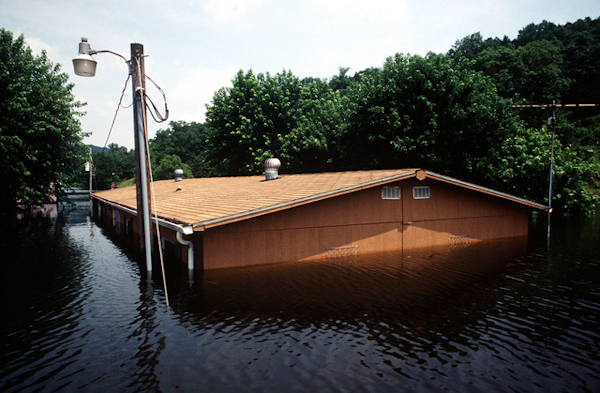SEJournal Online is the digital news magazine of the Society of Environmental Journalists. Learn more about SEJournal Online, including submission, subscription and advertising information.
 |
 |
| There’s no U.S. federal requirement for flood risk disclosure for home sales and nearly half of states don’t have one. Above, a home inundated by flooding in Missouri. Photo: U.S. National Archives. |
TipSheet: Do Home Buyers Have a Right to Flood Risk Disclosure?
By Joseph A. Davis
Part two of a two-part series addressing extreme weather and insurance. Read part one.
Disclosure saves lives and dollars.
 |
So journalists looking for local angles on the climate story may want to check out their state’s law on flood risk disclosure for home sales. Including whether they have one or not. In the year 2024, this could well be an important story in your area.
Keep in mind that there is no federal law or rule requiring flood risk disclosure. So nearly half of the states don’t have one.
Of the roughly half of all states that do have laws requiring home sellers to disclose whether the property is in a flood plain and whether it has ever been flooded, requirements vary in stringency.
In some states, the laws aren’t good enough. In some, like New York, flood risk disclosure law is being tightened up.
Why it matters
If you have ever had to clean up the mold and muck left after a flood or even lost everything you own in one, you’ll know why risk disclosure matters.
Floods today are showing up
not only in the same old places
but in surprisingly new places.
Part of the problem is that floods today are showing up not only in the same old places but in surprisingly new places that nobody thought were at risk.
The reason for this is often climate change, which can cause more big storms and intense precipitation. With climate change now upon us, we can expect surprises.
The backstory
It has been standard practice in some areas to legally require property sellers to disclose risks to potential buyers. That may also go for asbestos, lead paint and other hazards. But not always for flood risk.
No lengthy history is needed here.
Just look at what Hurricane Katrina
did to New Orleans. Or look at the
July 2023 floods in Vermont.
No lengthy history is needed here. Just look at what Hurricane Katrina did to New Orleans. Or look at the July 2023 floods (may require subscription) in Vermont and New England. Seemingly, against all odds (may require subscription).
Here’s the problem for risk disclosure in a nutshell: A lot of flood risk estimates are based on obsolete numbers. Drainage systems, dams, etc., may be engineered for a “100-year” flood — one likely to occur in the maps used for the National Flood Insurance Program by the Federal Emergency Management Agency, or FEMA.
Story ideas and questions to ask
- Find out whether your state has a climate risk disclosure requirement for real estate transactions. Get a copy and scrutinize it. Any loopholes? Who is (or is not) covered?
- Talk to local real estate agents (preferably ones who represent both buyers and sellers). What is their experience with sales in flood-prone areas? Ask about risk disclosure rules.
- Talk to home inspectors in your area. These professionals are hired by potential buyers to look for defects or problems in a property pending sale. What is their experience with flooding? What signs do they look for when evaluating flood risk?
- Ask local banks and lending institutions if they finance home sales without flood risk disclosure.
- Talk to zoning board members and city/county planners. Do local rules discourage home development in flood-risk areas?
- Talk to your local sewer and stormwater management officials. Do they have estimates of the capacity of local drainage systems (may require subscription) to handle stormwater volumes and rates? How do these compare to estimates of maximum possible precipitation?
- Do FEMA flood risk maps for your community adequately represent the actual risk in light of the past decade’s events? In light of recent developments?
- Are there properties in your area that have been “grandfathered in” even if new construction is forbidden in flood areas?
- Does the built environment in your area lower or heighten flood risk? For example: Culverts, bridges, retention ponds, etc.
- How well are the drainage systems in your area maintained? For example, catch basins and retention ponds in stormwater systems can make flooding worse if they are not regularly cleared of sediment and debris.
- Does your area have one or more flood control districts? If so, talk to the managers about changing flood risks, management and disclosure.
Reporting resources
- FEMA Flood Maps: They’re hardly perfect, but are a good starting place. FEMA has other info on flood risk disclosure as well.
- Risk Factor: A project of First Street Foundation that offers searchable, quality tools for estimating flood risk and other climate risks. Partly free. Has a search tool that allows you to look up multiple risks related to a specific property.
- Association of State Floodplain Managers: This group offers lots of info on flood risks. It has a model law on flood risk disclosure.
- National Association of Realtors: A national professional and lobbying group for real estate agents.
- Natural Resources Defense Council: The NRDC is an environmental advocacy group with an interest in flood risk. More info here.
- Insurance Information Institute: This organization of insurance companies has some useful fact sheets and stats on flood risk.
- Urban Land Institute: A network of cross-disciplinary real estate and land use experts, with a recent report on climate-related risk disclosure.
[Editor’s Note: For more on extreme weather and insurance, we’ve got a variety of related TipSheets, including on extreme rainfall, displaced victims, wildfire insurance, disaster aid, problems with building codes, flood-resistant building construction, covering the financial risks of climate change, and on earlier debates over flood insurance reform. Keep up to date on insurance-related headlines with EJToday. Plus, additional resources for your coverage can be found in our Topic on the Beat pages on disasters, hurricanes, wildfire and climate change. And be sure to check out our evolving Climate Change Resource Guide.]
Joseph A. Davis is a freelance writer/editor in Washington, D.C. who has been writing about the environment since 1976. He writes SEJournal Online's TipSheet, Reporter's Toolbox and Issue Backgrounder, and curates SEJ's weekday news headlines service EJToday and @EJTodayNews. Davis also directs SEJ's Freedom of Information Project and writes the WatchDog opinion column.
* From the weekly news magazine SEJournal Online, Vol. 8, No. 38. Content from each new issue of SEJournal Online is available to the public via the SEJournal Online main page. Subscribe to the e-newsletter here. And see past issues of the SEJournal archived here.












 Advertisement
Advertisement 



